Introduction
One of the key objectives of any business is to maximize profits while reducing operating costs — this allows the company to increase capital and gradually acquire a more significant niche in the industry market. There is a myriad of strategies that can be used to maximize profits (Kurochkina et al., 2019; CBR, 2018). Among the classic examples, it is reasonable to mention investing in talent, reducing operating costs by degrading resources used for the industry, expanding markets, refinancing existing loans, and more strategies that can be used by companies depending on individual characteristics and application goals. Among other things, one of the most frequently used and widely discussed strategies is outsourcing.
Notably, there is no unified view of what outsourcing is in academic discourse. For example, according to the Cambridge Dictionary, outsourcing should be understood as “the process of paying to have part of a company’s work done by another company” (Cambridge Dictionary, 2022). This interpretation reveals two essential characteristics of outsourcing, namely the need for a commercial agreement between companies and the delegation of part of the business functions to another organization. In the academic literature, it is possible to find a definition of outsourcing as a business productivity improvement method and an organizational development tool (Kavosi et al., 2018). In this case, outsourcing is perceived as some intangible tool designed to improve the operational efficiency of the company by transferring part of the functions to other organizations. More specifically, the authors report that the parent company’s improved efficiency comes at the expense of the reduced organizational costs that arise from outsourcing (Rode, 2022). In other words, to summarize, the following interpretation of the phenomenon of outsourcing can be constructed: outsourcing is a business process that allows to significantly reduce the operating costs of the parent company through a commercial agreement with the subsidiary company, implemented through the transfer of part of the business functions.
Outsourcing strategy can be implemented for any business function, from office cleaning services or catering for employees to the development of critical software that directly influences brand business strategies. Based on the plurality of views, there are several classifications in the literature that explain the types of outsourcing for a company. For example, Figure 1 shows a diagram revealing the concepts of domestic and international outsourcing. It is clearly seen that outsourcing is divided into two categories depending on the geography of the subsidiary company to which the business functions have been delegated. In addition, there is a differentiation of international outsourcing into offshoring and nearshoring, depending on how far the company is located.
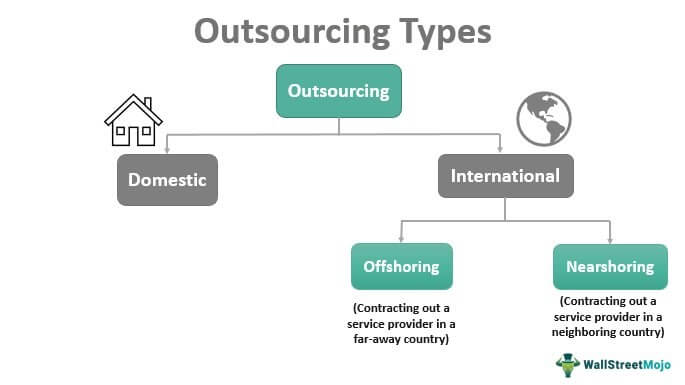
There is also an alternative classification of outsourcing based on the criteria of business forms outsourced to a third-party company. Figure 2 provides information on these seven such types; this refers to the type of production, the specific business function that has been outsourced, the duration of outsourcing, and specialization. One of the most common types of outsourcing is the delegation of business processes, regardless of which function is outsourced to another company (Outsource Accelerator, 2022). For example, organizing a customer service hotline through the efforts of another company is business process outsourcing, which aims to improve the operational efficiency of the business by not performing these functions independently and while investing in the implementation of services through another company (Ye, Zhu, and Mukhopadhyay, 2014). Among other things, Figure 2 includes information on IT outsourcing, in which a company hires third parties to perform software development and support. One of the textbook examples of such outsourcing is the Chinese company Alibaba, which conducts its functions in the field of e-commerce. It is known that in the initial stages of organizational development, Alibaba outsourced its IT functions to US developers to create a virtual architecture and website for Alibaba (Mohite, 2021). In this case, such outsourcing could be classified as offshore IT outsourcing.
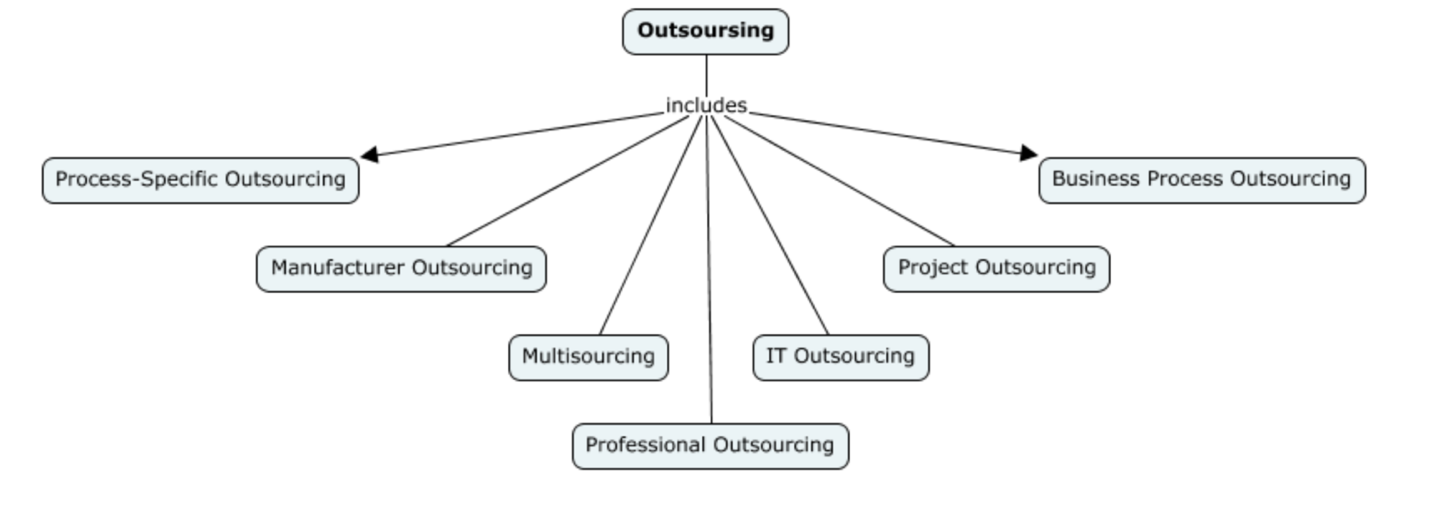
Driving Forces of Outsourcing
At first glance, the decision to invest in outsourcing is mediated by the desire to reduce a company’s operating costs by delegating responsibilities significantly. In this sense, the main driving force is the cost of labor. It is well known that labor is cheaper in low-income countries (Le, Duy, and Ngoc, 2019). For example, the cost of labor for China in March 2022 was, on average, 56.5 percent lower than the same cost in the United States (TE, 2022). Also on the list of countries with the lowest labor costs by 2018-2022, in addition to China, are Serbia, Taiwan, Moldova, and Argentina (ILO, 2018; TE, 2022). To put it another way, there are countries in the global market arena where acquiring labor proves to be a better investment than using domestic labor. Including, hiring employees from another country on an outsourcing basis allows a company to save on its tax system (Brown, 2018). From the above, one can conclude that it makes sense for companies from high-income countries to invest in hiring labor in low-income countries because it allows them to reduce wage and compensation costs.
The cost of labor, however, is not the only metric that justifies outsourcing. As can be seen in the example of China’s Alibaba, the country has invested in outsourcing to the United States, where labor costs are nearly double (Mohite, 2021). In this case, the driving force is the management of talent hired on a systematic basis or for projects. The Chinese company could not find experienced developers among the locals and was convinced that American specialists would help it create the best IT architecture — for this reason, Alibaba invested in the higher-income country. Talent management as a driver has advantages in both the short and long term (Ansar and Baloch, 2018). Specifically, in the short term, the company, despite having to pay more, gets more talented and professional employees, which helps solve a specific problem. At the same time, with long-term talent, the company invests in a more highly skilled workforce to systematically improve its own business performance. Remarkably, in this case, the company also saves on training new employees since it hires professionals who can start project activities at once.
Business expansion is also one of the reasons for active outsourcing. If a company enters the organizational stage of expansion in the development cycle, the number of business processes increases significantly. If a company’s staffing structure does not have enough workforce to implement the expanded business processes, outsourcing is a smart strategy to optimize operational efficiency (Guercini and Milanesi, 2018). Delegating part of the functions can be implemented both by transferring critical aspects of the business, such as software development, and related processes to establish productivity, including the organization of cleaning in the company.
An essential factor in the process of delegating responsibilities is the responsibility that is shared between the companies. When a parent organization outsources some functions, it assigns responsibility to outside employees to implement those processes (Apple, 2022b). In this case, the driving force behind the company is a reluctance to have responsibility for doable work on its own, but instead a desire to allocate levels of responsibility. This strategy embodies the idea of reducing the level of business risk associated with specific projects or on a systematic basis.
Additional drivers of outsourcing also include technological reasons. For example, Dude, Zitkiene, and Kazlauskiene (2022) point out that a company’s lack of specific technology is a driving force for outsourcing because, in this case, the organization seeks collaboration with other firms. This is especially true if the work task requires highly specialized equipment that is expensive. The company may not need such equipment on a regular basis and investing in its purchase would be a strategically poor decision — instead, the company outsources the task to those firms that have such equipment. The solution saves significant time and budget, as well as sharing responsibility.
Finally, one of the most critical drivers of outsourcing, extremely common in multinational companies, is the need for strategic profiling. More specifically, when a company performs an extensive range of services and uses many business processes, the distribution of attention significantly reduces the opportunities for strategic vision. In this case, profiling, implemented through the delegation of rank-and-file business processes to outsourcing, allows the company to focus attention on strategic development issues (Sigroha, 2019). One clear example, discussed in more detail in the following sections, is Apple, Inc., which outsources manufacturing functions to other countries while retaining resources to implement the firm’s strategic development (Apple, 2022b). In a general sense, outsourcing allows for significant financial savings, talent management, and operational efficiencies, so this change strategy is valuable from an organizational development perspective.
The Benefits of this Strategy
In addition to the already mentioned reductions in operating costs and increases in company productivity, outsourcing has several additional proven advantages over other change management strategies. These include creating a unique organizational culture in which new employees are not part of the corporate environment, allowing the company to save resources on managing communication and HRM within the firm, and not spending finances or time on outside workers (Ye et al., 2014). At the same time, when the business expands, using outsourcing helps to take some of the functions off the current employees and delegate them to outsource, which in turn has a positive effect on the employees (Edvardsson and Óskarsson, 2021). With more free time, they can pay more attention to the task at hand or invest in their well-being. In addition, the advantage of outsourcing is the effect of organizational flexibility, which helps the company to achieve better results. When a firm clearly understands that a number of specific organizational tasks can be carried out through outsourcing and takes advantage of that, it creates operational flexibility. The company forms a vision in which the occurrence of almost any problem can be solved by seeking proper outsourcing, so managing and adapting to change is less painful.
Consulting academic sources will find the real benefits of outsourcing as a change management strategy. Research in Liberia has shown that outsourcing a business management function does increase employee productivity and performance (Romero, Sandefur, and Sandholtz, 2020). Proper outsourcing can also stimulate increased brand credibility if the firm has been able to select responsible and competent third-party employees (Landay and DeArmond, 2018). In a study using a survey of apparel business employees to determine the key benefits of an outsourcing strategy, outsourcing was found to overcome organizational obstacles beyond the firm’s capabilities (Kayar and Bulur, 2019). In addition, time savings, increased flexibility, and improved quality were identified as clear benefits of outsourcing for the firm. Additional benefits were also identified as increasing the company’s investment appeal through an increased culture of transparency (Junaydullaevich, 2021). This finding is particularly relevant regarding outsourcing key business processes, whether accounting, software development, or HR practices. Thus, outsourcing defines multiple business benefits, allowing for significant optimization of production processes. Figure 3 summarizes the information created because of the literature search for the benefits of outsourcing strategies.

Case Study Overview
Company Identified
Apple, Inc. is a world-renowned leader in the technological development and sales of electronic devices. Apple manufactures smartphones, tablets, computers, and related equipment that are widely used by consumers in all countries. There are currently more than 1.2 billion iPhones manufactured by Apple worldwide, and that number is expected to continue growing (Wise, 2022). The high popularity of the technology conglomerate regularly makes Apple a leader in commercial development; for example, its market capitalization will reach the $2.403 trillion mark by 2022, making Apple the most expensive company in the world (CMC, 2022). The need for this firm to keep its established investment appeal, combined with the scale of its consumer base, makes Apple an exciting company to consider in terms of an outsourcing strategy.
The use of Apple’s outsourcing strategy for change management has been the subject of much public and academic work. It is believed that it was Apple, under the leadership of Tim Cook, who was able to build an optimal diversified supply chain and create an outsourcing system that significantly enhances the company’s operations (Gallagher, 2021). In particular, the manufacturing center for all Apple devices is China, even though the brand is headquartered in Silicon Valley (Figure 4). Apple retains the critical strategic decision-making and management function of the firm but outsources the day-to-day tasks, including device assembly and bundling. Business processes related to performance testing of new products and software audits are also delegated to third parties. In turn, through such a system, added value per product is generated, as shown in Figure 5. Kasyanenko (2019) reports that the main reason for outsourcing at Apple is not so much to reduce operating costs — although it is clear from the company’s market capitalization that this strategy is showing success for the budget as well — but to speed up production processes. Apple regularly releases a whole line of new devices and software every year, which requires a tremendous amount of work and resources from the firm — in this sense, outsourcing helps to cover this need and maximize operational efficiency.
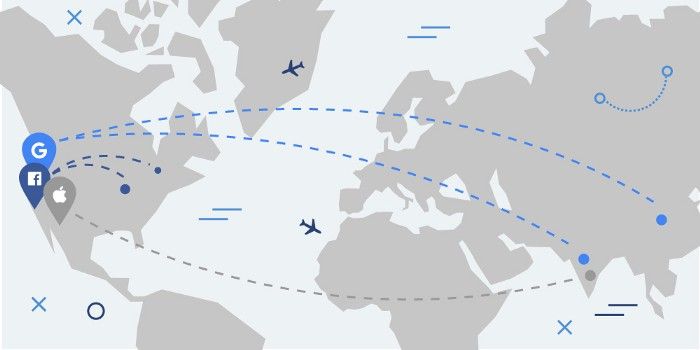
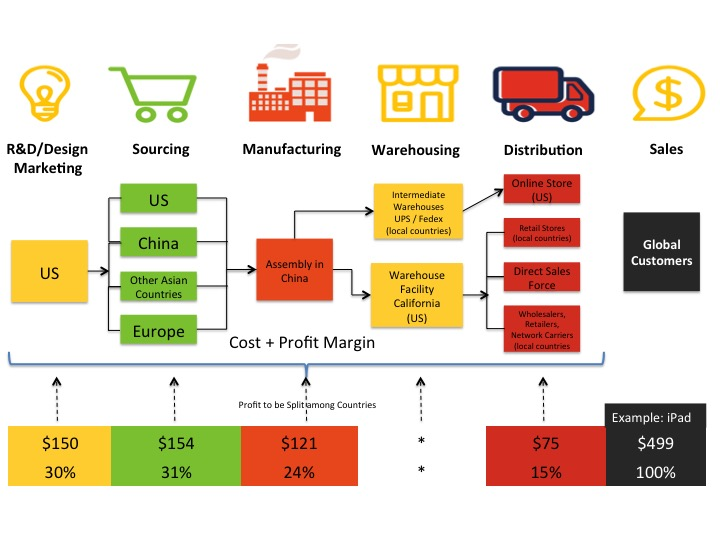
Stakeholder Analysis
For Apple, it is fair to identify several key stakeholders involved in the outsourcing strategy. For ease of visualization, the stakeholders and their descriptions of involvement in outsourcing processes are summarized in Table 1.
Table 1: List and characteristics of apple stakeholders
Change Assessment
Any business is strongly associated with adaptation to change, and as already shown, outsourcing is such a tool that allows to significantly optimize the production efficiency of the company in a dynamic market. Scientific and educational literature presents many models that are designed to diagnose change and readiness for change within a company. Among them, particular attention should be paid to Weisbord’s 6 Box Model as a tool that helps to assess change in the company from within (Ihsani, 2020). Figure 6 describes the conceptual diagram of this model: it is clearly visible that the tool consists of six elements, which include Purposes, Structure, Rewards, Helpful mechanisms, relationships, and leadership in the center of the model. The central goal of using this model is to develop a deeper understanding of the meaning of change in the company and to discover ways for further strategic development.
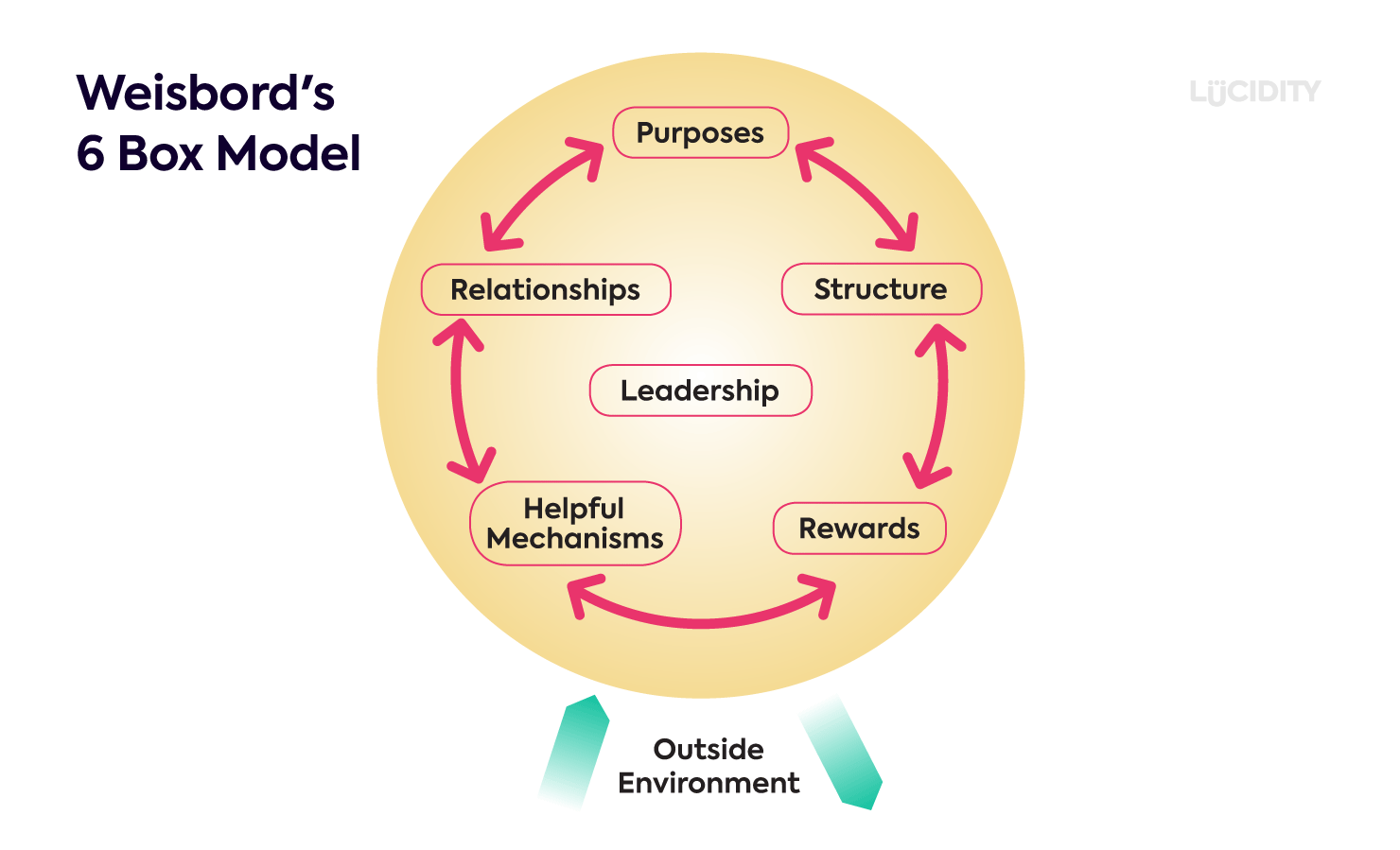
All components of the model are equivalent and non-excludable, with each covering its functional focus. For example, Structure defines the appropriateness of business processes, while the Relationship Box describes the thoroughness of communication within the company and the rules for resolving conflicts that arise (Lucidity, 2019; Ihsani, 2020). Rewards are designed to characterize systems for rewarding and motivating employees within the organization, including both tangible and intangible benefits. Helpful mechanisms are models and systems in organizational practices that supply opportunities for the strategic development of the company. The Purposes block helps in defining the company’s purpose and vision for the industry market and helps in identifying weaknesses in the very foundation of the business. Finally, the Leadership block reflects the management values in the organizational culture, explaining leadership styles and patterns of leadership and employee motivation. It is worth clarifying that this model is designed only for the internal assessment of changes in the company and is not able to assess the impact of external factors — in other words, the model can be extended with additional tools to form a complete vision of the brand in the market. Thus, Weisbord’s 6 Box model is a tool for change assessment from the position of internal context, allowing to cover many components of the organizational environment.
The motivation for selecting this model is determined by the clear benefits provided by the use of Weisbord’s 6 Box. In particular, combined with its ease of application, the model is able to cover a large number of variables and provide an almost complete picture of the business processes and relationships within the company. In addition, unlike many other models, including McKinsey’s 7S, or Six Sigma Model, Weisbord’s 6 Box helps diagnose a business rather than simply describing its position in the industry market or in relation to competitors. Finally, there is much literature on the model, which makes it a time-tested and proven tool. Weisbord’s 6 Box can be applied to Apple’s organizational practices to diagnose changes in the company.
Applying Weisbord’s 6 Box to Apple
Purpose
Purpose generally examines the essence of business existence and assesses the potential problems embedded in the company’s foundation (Lucidity, 2019). Apple’s mission is “to bring the best personal computing products and support to students, educators, designers, scientists, engineers, businesspersons and consumers in over 140 countries around the world” (Rowland, 2022, para. 2). In this context, the company seeks to make a global impact that would be impossible for a multinational company to make in just one region. The need for change related to outsourcing stems directly from Apple’s fundamental value. As the stakeholder analysis has shown, Apple supports this strategy and has no problems associated with outsourcing and Purpose.
Structure
Structure in the company examines the design of the business created and answers whether the organizational structure makes sense for what the company is trying to achieve in the marketplace (Lucidity, 2019). Along with going global, Apple has undergone significant organizational changes related to supply chain systems and outsourcing workers from lower-income countries. The current agenda of hiring workers from other regions gives Apple more financial freedom and resources to invest in development and design, allowing the company to operate more efficiently (Cassidy, Gravois, and Solomon, 2019). In other words, it is outsourcing as part of the company’s structure that helps achieve the company’s stated mission and ensures that the company’s key strategies are implemented. On the other hand, outsourcing as part of the organizational structure creates additional barriers to logistical efficiency, significantly when geopolitical stability is disrupted, as the pandemic has shown (Mearian, 2022). Supply chain disruption significantly impacts Apple’s capabilities and negatively impacts the company’s commercial success.
Relationships
Relationships are an intangible asset of a company that allows it to influence business strategy and determine communication opportunities between stakeholders (Lucidity, 2019). Apple maintains close relationships with third-party companies: one of the critical companies hired by Apple to outsource is Foxconn. From media analysis, Apple regularly meets and maintains a dialogue with employees of outsourcing companies, which fosters a partnership and trusting relationship between the head office and third-party companies (White, 2020). As a result of this close cooperation, Chinese companies have become industry market leaders, which benefits the national economy (Ma, 2021). On the other hand, media data also show that Apple has found itself at the center of reputational scandals related to the exploitation of child labor (Sonnemaker, 2021). In this sense, the lack of transparency in relationships created the potential for damage to the company and negatively affected consumer attitudes toward Apple. Thus, the company’s relationship system is not built well enough and shows serious flaws.
Rewards
Rewards and compensation systems are tools to increase stakeholder motivation, which positively impacts productivity (Lucidity, 2019). Apple’s practice has also consistently used outsourced employee compensation strategies. Apple understands that the company’s ultimate productivity and, as a result, profits depend on the motivation of its supplier companies’ employees. For this reason, the company launched a program in 2022 to improve the working conditions of its outsourced employees and create a supportive work environment (Apple, 2022a). This is a significant contribution for multinational companies, which typically shift responsibility for employee compensation and motivation to outsourcing companies and do not do it themselves; Apple, on the other hand, is setting an example of social responsibility for the employees it hires. In contrast, data from independent analyst agencies refute Apple’s audit of worker well-being and report that the company’s outsourced employees suffer from untimely wages, unpaid overtime hours, and pressured treatment by managers, which includes employee deaths (CLW, 2020). This creates uncertainty about Apple’s efforts to achieve a favorable compensation system and motivate employees to work.
Helpful Mechanisms
The Helpful Mechanisms block focuses on examining the company’s systems and tools to achieve its goal (Lucidity, 2019). To achieve its mission, Apple practices ethical considerations for outsourcing stated formally (Apple, 2022b). Specifically, the company has formed a code of ethics that imposes restrictions on outsourcing organizations: among the key excerpts from the code: the need for an employee from another country to reach the age of fifteen, refuse to perform life-threatening work, and reduce work hours to 60 hours per week (Apple, 2022b). However, practice shows that not all outsourcers properly comply with company ethical requirements (CLW, 2020; Sonnemaker, 2021). Thus, the company does not demonstrate high quality in terms of Helpful Mechanisms.
Leaderships
Leadership is another intangible company asset that looks at aspects of effective management and precise adherence to brand values (Lucidity, 2019). From a leadership perspective, Apple practices a democratic leadership style to inspire and motivate outsourced employees (Schmitt, 2022). Management recognizes the value of employee training and invests a significant portion of its budget in educational programs that develop talent (Apple, 2022c). In addition, Apple confidently assigns suppliers responsibilities, creating an environment for minimizing risk and effectively managing all phases of product production. In doing so, the company strives to create a supportive and fair work environment for outsourcers and invests in the well-being of employees (Apple, 2022d). Thus, in terms of leadership, Apple shows valuable results regarding outsourcers and creates sufficient conditions for organizational development.
Table 2: Expectations and Realities measured for Apple using Weisbord’s 6 Box
Evaluation
To develop Apple in the global market, the company needed to invest in outsourcing as a tool to maximize profits while seriously reducing costs and risks. Outsourcing for Apple is a resource that allows it to realize its brand mission; however, on the way to implementing this strategy, the company faced several barriers identified through Weisbord’s 6 Box. Severe barriers to achieving operational excellence and reliably translating values into organizational practices were found in terms of structure, relationships, rewards, and utility mechanisms. In particular, the company does not effectively manage outsourcers, which creates reputational and labor barriers: the use of child labor, late payment of wages, and poor HR practices of outsourcers pose threats to embodying Apple’s mission (CLW, 2020; Sonnemaker, 2021). The expansion of the supply chain leads to an increase in the number of parties involved in outsourcing processes, which also imposes severe reputational and economic risks on the company. For example, if any of Apple’s outsourcing companies were at the center of a scandal, it would damage the brand. In addition, outsourcing to Apple is not immune to threats of geopolitical scale and may show negative performance (Mearian, 2022). Thus, the company’s outsourcing strategy is associated with many barriers and risks.
While Apple has clear limitations, this change management strategy still defines critical brand success. Weisbord’s 6 Box model also shows that outsourcing helps Apple significantly reduce costs and speed up production, with the side effect of investing in other countries’ national economies. The global supply chain created by Apple allows new products to be created quickly and brought to market for consumers, which increases the company’s capitalization. The company’s leadership also drives well-being for all stakeholders, which is expressed, among other things, through Apple’s efforts to train and improve the working conditions of outsourced workers.
In other words, it cannot be said that the decision to outsource as part of organizational change was strictly positive or negative; instead, it had both obvious benefits and limitations. In response to threats and disadvantages, Apple is advised to carefully examine the situation and make swift decisions to address the risks. For example, the harm associated with the exploitation of child labor should be addressed immediately by raising the minimum age bar and increasing oversight of outsourcing companies. In addition, labor conditions are recommended to be addressed by increasing transparency in brand operating practices and transparent oversight of outsourcers so as not to create a gap between Apple’s ethical values and actual practices on the ground (McDonald, 2022; CLW, 2020). In terms of pandemic impact, it is recommended that the company create a fallback branch in the supply chain and establish multi-channel manufacturing to reduce the risk to customers if one of the plants closes (Deliverr, 2018). Thus, a key recommendation for Apple is to develop preventive controls over suppliers and to outsource responsibly.
Reference List
Ansar, N. and Baloch, A. (2018) ‘Talent and talent management: definition and issues’, IBT Journal of Business Studies, 14(2), pp. 213-230.
Apple (2022a) Apple launches $50 million Supplier Employee Development Fund. Web.
Apple (2022b) Apple Supplier Code of Conduct. Web.
Apple (2022c) Career growth. There’s a path for that. Web.
Apple (2022d) Apple and procurement. Web.
Brown, M. (2018) How the tax cuts and jobs act will impact outsourcing. Web.
Cambridge Dictionary (2022) Outsource. Web.
Cassidy, C.M., Gravois, R. and Solomon, S. (2019) ‘outsourcing to China: the benefits and consequences of Foxconn’s strategy’, Southeast Case Research Journal, 16(1), pp. 8-39.
CBR (2018) Should public companies do more than maximize profits? Web.
CLW (2020) Improvement or just public relations? China labor watch challenges Apple’s statement on Pegatron. Web.
Schmitt, K. R. (2022) What is Tim Cook’s managerial style? Web.
CMC (2022) Market capitalization of Apple (AAPL). Web.
Deliverr (2018) The risks and benefits of outsourcing supply chain management. Web.
Dude, U., Zitkiene, R., and Kazlauskiene, E. (2022) ‘An assessment of the impact of the drivers of outsourcing on service delivery in organizational networks’, Montenegrin Journal of Economics, 18(3), pp. 169-182.
Edvardsson, I.R. and Óskarsson, G.K. (2021) ‘Outsourcing of human resources: the case of small-and medium-sized enterprises’, Merits, 1(1), pp. 5-15.
Gallagher, W. (2021) How Tim Cook reshaped Apple in his first decade as CEO. Web.
Guercini, S. and Milanesi, M. (2018) ‘Understanding changes within business networks: evidences from the international expansion of fashion firms’, Journal of Business & Industrial Marketing, 34(1), 192-204.
Ihsani, R.K. (2020) Pengembangan organisasi dengan model diagnosa Six-Box Weisbord. Jurnal Sains Sosial dan Humaniora, 4(2), pp. 183-193.
ILO (2018) Statistics on labour costs. Web.
Infocom (2020) Apple stakeholder analysis. Web.
Junaydullaevich, A.A. (2021) ‘Today’s development of the benefits of outsourcing accounting services’, International Journal on Economics, Finance and Sustainable Development, 3(3), pp. 275-279.
Kasyanenko, S. (2019) iPhone made in India: Apple outsourcing strategy. Web.
Kavosi, Z., et al. (2018) ‘Factors influencing decision making for healthcare services outsourcing: a review and Delphi study’, Medical Journal of the Islamic Republic of Iran, 32, pp. 56-60.
Kayar, M. and Bulur, Ö.C. (2019) ‘An investigation of the benefits of using outsourcing for apparel companies’, International Journal of Innovative Research and Reviews, 3(1), pp. 6-10.
Kurochkina, A.A., et al. (2019) ‘Management features of small and medium-sized business enterprises’, Revista Espacios, 40(34), pp. 1-4.
Landay, K. and DeArmond, S. (2018) ‘Recruitment process outsourcing and recruiter and hiring firm characteristics: a two study investigation’, Journal of Personnel Psychology, 17(4), pp. 183-194.
Le, N.H., Duy, L.V.Q. and Ngoc, B.H. (2019) ‘Effects of foreign direct investment and human capital on labour productivity: evidence from Vietnam’, The Journal of Asian Finance, Economics and Business, 6(3), pp. 123-130.
Lucidity (2019) Guide to Weisbord’s 6 Box model. Web.
Ma, W. (2021) How Apple grew closer to China by turning ‘little Foxconn’ into a national champion. Web.
McDonald, J. (2022) 7 poor working conditions that hurt employee productivity. Web.
Mearian, L. (2022) Apple supplier Foxconn halts production amid COVID-19 outbreak in China. Web.
Mohite, B. (2021) Alibaba – from small apartment to world’s largest marketplace. Web.
Outsource Accelerator (2022) Different types of outsourcing that you need to know. Web.
Rode, M.S. (2022) ‘Outsourcing is need of market: banking services’, International Journal of Research Publication and Reviews, 3(1), pp. 93-97.
Romero, M., Sandefur, J. and Sandholtz, W.A. (2020) ‘Outsourcing education: experimental evidence from Liberia’, American Economic Review, 110(2), pp. 364-400.
Rowland, C. (2022) Apple Inc.’s mission statement and vision statement (an analysis). Web.
Sigroha, A. (2019) ‘Human resource outsourcing: types and motivating drivers of outsourcing in an organization’, Think India Journal, 22(14), pp. 431-439.
Sonnemaker, T. (2021) Apple knew a supplier was using child labor but took 3 years to fully cut ties, despite the company’s promises to hold itself to the ‘highest standards,’ report says. Web.
TE (2022) Labour costs. Web.
Vaidya, D. (2021) Outsourcing. Web.
White, G. (2020) Apple CEO Tim Cook visits Foxconn’s manufacturing factory in China. Web.
Wise, J. (2022) How many iPhones are there in 2022? Web.
Ye, G., Zhu, X., and Mukhopadhyay, S.K. (2014) ‘Managing service quality in multiple outsourcing’, International Journal of Electronic Commerce, 18(3), pp. 125-149.
